
BACKGROUND – TALKING POINTS – ACTIONS – VOICES – STORIES
![]()

World War II will be remembered in infamy for countless reasons – the most horrific being the systematic extermination of 6 million Jews during the Holocaust. As many around the world observe Yom HaShoah – Israel’s solemn Holocaust Remembrance Day – on April 24, it is crucial to commemorate the traumatizing experiences that Allied soldiers witnessed while liberating Nazi concentration camps.
In the spring of 1945, as troops pushed deeper into the collapsing Nazi regime, American forces encountered scenes that defied comprehension. Thousands of young soldiers – far from home and hardened by war – were unprepared for the horrifying cruelty and dehumanization they encountered. Soviet forces liberated Auschwitz-Birkenau, while British and Canadian troops liberated other notorious death camps. For these soldiers, the liberation of Nazi death camps became more than just a military operation – they documented the horrors of the Holocaust. This sent many spiraling into a nightmare that would forever alter their understanding of humanity.
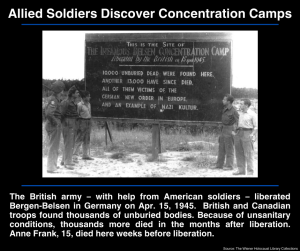
Unforeseen Horror: ‘War did not prepare us for this’
Gen. Patton’s troops at Buchenwald, the 45th Infantry Division at Dachau and the 7th Army at Landsberg did not face enemy combatants in these camps. They confronted the victims of a genocidal ideology: the emaciated survivors, the piles of corpses and the overwhelming stench of death. This was not the expected brutality of battle, but a calculated and industrialized system of extermination, fueled by a virulent hatred of Jews – antisemitism – and other targeted groups.
U.S. veteran Ernest James recalled the shock his unit encountered at the Dora-Mittelbau concentration camp in Germany: “It’s indescribable. Some of my men threw up, others got violently angry. First of all, we were almost numbed to war. We’ve been in war from June to April and almost constantly in battle of one sort or another. We’d seen many, many people who were killed, violently killed. Yet, none of that had the same effect as seeing all this.”
The soldiers’ experiences transcended the horrors of conventional warfare. They found themselves thrust into a world where human beings were systematically stripped of their humanity, reduced to skeletal figures and subjected to unimaginable suffering. The soldiers witnessed the devastating consequences of unchecked hatred of Jews – a sight that would haunt their memories for decades to come.
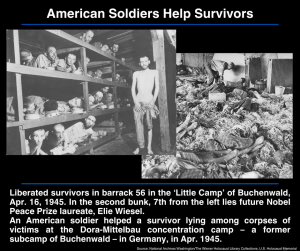
Documenting Atrocities: ‘Take photos to prevent Holocaust denial’
The liberation of extermination camps was a profoundly gut-wrenching experience for soldiers. Amid the shock and horror, they were compelled to act. They provided immediate aid to the survivors, sharing their rations, arranging for medical care and documenting the atrocities for the world to see. The liberators became witnesses to a crime against humanity on a scale that few could have imagined. Their actions in the aftermath of liberation played a crucial role in bringing the truth of the Holocaust to light.
American liberator Alan Moskin served under Gen. Patton. In Alan’s testimony, he recalled the orders delivered by his captain, in the name of Gen. Dwight D. Eisenhower, Supreme Commander of the Allied Expeditionary Force: “I want you to take photos, I want you to get everything down, I don’t want my ‘grunts’ to pick up those bodies. I want you to bring people in from town, bring the trucks, let them see the bodies, make them put them on the trucks, because someday people are going to say we made it up. They won’t believe it.” Gen. Eisenhower correctly predicted Holocaust denial.
Alan also described the effects of what he witnessed: “I had severe nightmares after the war. I was crying, I had sweats and fits of cursing. They called it shell shock and battle fatigue, and they didn’t know how to treat it. So I locked up part of my brain and said I was not going to talk about those experiences because I was afraid to bring back those memories. I didn’t tell my wife or kids.” He did not speak about his experience until 1995. Dachau liberator Seymour Kaplan was not diagnosed with post-traumatic stress disorder until 2009.
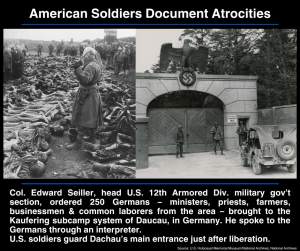
Enduring Impact: ‘Liberators suffered terribly’
George Kaiser, liberator at Dachau: “It was as if I had entered hell. The smell was so overpowering I got sick and ran out. In the courtyard, I couldn’t move. My mind froze. The shock was complete and total. Especially when we saw the crematoria – it was still hot, with these piles of bodies, stacked five bodies high.” George began shaking when he told his story to Leila Levinson, a therapist and daughter of a liberator, who interviewed Americans in Concentration Camp Liberators Reveal Their Silent Trauma.
Nat Futterman: “When we got outside of Germany, you could smell something was wrong. Smell it. The thing that got me was when I looked at the leaves on the trees. I said what the hell is the matter with them? The leaves were gray. I rubbed one, and it was covered with ash. What is this? And then when we walked through the gates. It’s very hard to even think about it because it was so overwhelming.” Nat also trembled when recounting his story.
Levinson summarized the tragedies faced by the liberators: “We need to acknowledge how the GIs who liberated the Nazi death camps have suffered terribly from what they witnessed. We need to put into the record of history that by stumbling upon the camps without any preparation, these men and women would be haunted for the rest of their lives by the images and smells of the Final Solution’s gruesome last moments.”
Remembrance: ‘48% of American young adults could not name a concentration camp’
Dr. George Tievsky, a physician who participated in the liberation of Dachau: “I didn’t talk about it for 40 years. I couldn’t talk about it because there were no words that could describe the horror. Also, my own mother would say ‘Forget about it, don’t even talk about it, it’s all behind you now.’ People seemed so oblivious, unconcerned. Oh, those concentration camps couldn’t have been that terrible.’ I heard them say more about going to a bad movie.”
Recent Holocaust knowledge surveys showed shocking levels of ignorance – especially among Gen Z and Millennials – across America and around the world. An alarming number of individuals could not name a single concentration camp, did not know what Auschwitz was, did not know that 6 million Jews were killed in the Holocaust – or thought it was less than 2 million – and even think that Jews caused the Holocaust.
Yom HaShoah serves as a crucial reminder of this dark chapter in human history. It is a day to mourn the millions who perished and to honor those who, like the American liberators, confronted its horrors. Their story is a testament to both the depths of human cruelty and the resilience of the human spirit.
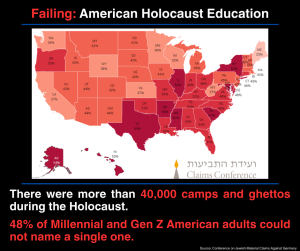
MTV Airing Oct. 7 Documentary
American singer, dancer and activist Montana Tucker – granddaughter of Auschwitz survivors – interviewed Israeli children for a documentary, The Children of October 7. MTV will air the 36-minute film commercial-free for Yom HaShoah on Thursday, Apr. 24, at 9 pm Eastern.
“Hearing children, ages 11 to 17, describe being taken hostage by Hamas, witnessing their families murdered, losing their homes and innocence in one morning – felt hauntingly familiar,” Tucker said. “There is a painful and undeniable parallel between the testimonies of Holocaust survivors and the testimonies from these children. The fear, the loss, the trauma – it’s the same. History is repeating itself, and we cannot stay silent.” An Israeli therapist described the trauma suffered by Israeli children since 10/7.
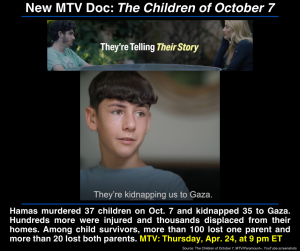
![]()

![]()

Observances of Yom HaShoah
Just as Israelis pause in profound silence as a nationwide siren pierces the air at 10 am – bringing life to a standstill in collective memory – we can find meaningful ways to observe Holocaust Remembrance Day:
![]()

Pope Francis – who advanced church’s relationships with Jews – dies at 88; Jewish groups respond to his passing

A Pope, a Book and a Soccer Team
By Rabbi Eric J. Greenberg, National Director of Partnerships and Multifaith Engagement, The Focus Project
I received an unexpected phone call in early 2012, from a stranger – an American Jew living in Argentina.
He knew I was involved in Catholic-Jewish relations and had an idea – publishing a book in the U.S. co-authored by Argentinian Rabbi Abrahan Skorka and the relatively unknown Cardinal Jorge Mario Bergoglio of Buenos Aires.
The book, “Between Heaven and Earth,” presented a series of conversations between the rabbi and the cardinal, including such hot-button issues as fundamentalism, homosexuality, abortion and the Holocaust.
The proposal sat on a shelf. But a year later, Pope Benedict XVI stunned the world by resigning, the first pope to do so in 600 years. And several weeks later, on March 13, 2013, the 76-year-old Buenos Aires cardinal became the first Latin American – and Jesuit – to be elected pope. Suddenly there was great interest in the book, and we were able to have it published.
At the same time, I received another unexpected phone call from a friend at the Vatican’s Pontifical Commission on Religious Relations with Jews. He was inviting me to attend the inauguration of the newly named Pope Francis the very next week, on March 19.
In Rome, on a sunny and warm spring day, more than 200,000 people poured into and around St. Peter’s Square for this historic inauguration. The small Jewish delegation I was part of included rabbis and Jewish leaders from Italy, Argentina, Israel and the United States. We were ushered to plastic folding chairs in the first rows – symbolic of the positive new relationship between the Roman Catholic Church and the Jewish people. Sitting nearby were such world leaders as Argentina’s President Cristina Fernandez and U.S. Vice President Joe Biden.
Later, I was invited to attend Pope Francis’ first interreligious gathering as pope. Faith leaders from around the world, including Eastern Orthodox, Anglican, Muslim, Jewish, Zoroastrian, were escorted into a resplendent Vatican meeting room to meet the new Pontiff.
I had put a lot of thought into what I wanted to say to Pope Francis – something more than the typical formal greeting. I consulted with an Argentinian friend who noted that the new pope loved soccer, “and I know his favorite team.”
When my friend, Msgr. Brian Farrell, introduced me to Pope Francis, I knew what to say. After thanking him for his book and important interfaith contributions, I concluded with: “Viva San Lorenzo.” Francis looked stunned. Then he smiled and began laughing, as did I. The other cardinals and religious leaders around us were left wondering what was so funny.
With my mission accomplished, I headed back to my seat. But Francis suddenly took hold of my arm and tugged me back for a last word. “Thank you for supporting my team,” he smiled.
Since that time, and until his death on Monday at the age of 88, Francis continued the historic work of his predecessors, Saint John Paul II and Benedict XVI in deepening the Catholic Church’s relationship with the Jewish people by condemning antisemitism and anti-Judaism and promoting dialogue and reconciliation.
Only last year, Francis met with the families of Israeli hostages, while also expressing criticism of Israel’s post Oct. 7 military response.
Jews, Catholics and all those who believe in the necessity of dialogue, education and building positive multifaith relations will be watching Rome closely for what happens next.
![]()

Stories Impacting American Jews
Stories Impacting the U.S. and Israel
![]()
In light of the surge of current relevant news, please subscribe to our Daily News Brief, a digest of critical news headlines curated from thousands of media addressing issues that affect the Jewish world.
![]()

This content is developed by The Focus Project in partnership with MERCAZ USA. The Focus Project distributes weekly news and talking points on timely issues concerning Israel and the Jewish people, including antisemitism, anti-Zionism and the delegitimization of Israel. It represents a consensus view across a spectrum of major American Jewish organizations. MERCAZ USA recognizes and respects the diversity of views on these issues among its readers and the community at large.
![]()